Global E-Prescription Solutions Market, By Offering, By Deployment Model, By Delivery Mode, By End User, By Region & Segmental Insights Trends and Forecast, 2024 – 2034
- Industry: Healthcare
- Report ID: TNR-110-1224
- Number of Pages: 420
- Table/Charts : Yes
- July, 2024
- Base Year : 2024
- No. of Companies : 10+
- No. of Countries : 29
- Views : 10107
- Covid Impact Covered: Yes
- War Impact Covered: Yes
- Formats : PDF, Excel, PPT
E-Prescription Solutions refer to digital systems used by healthcare providers to write, send, and manage prescriptions electronically. These solutions replace traditional paper prescriptions, aiming to streamline the process of prescribing medication and reduce errors. The e-prescription solutions market is experiencing robust growth, driven by the increasing demand for streamlined healthcare processes and enhanced patient safety. Key trends shaping the market include the rising adoption of electronic health records (EHR) and the growing emphasis on reducing medication errors through advanced digital solutions.
The proliferation of cloud-based technologies and the integration of artificial intelligence (AI) are further fuelling market expansion by improving prescription accuracy and operational efficiency. Government initiatives and incentives supporting digital health transformation are accelerating market growth. Increased consumer preference for convenient, paperless transactions and the need for better regulatory compliance are also significant growth drivers. Collectively, these factors are poised to drive sustained development and innovation within the e-prescription solutions sector. In Terms of Revenue, the Global E-Prescription Solutions Market was Worth US$ 3.7 Bn in 2023, Anticipated to Witness CAGR of 23.4% During 2024 – 2034.

Trends in the Global E-Prescription Solutions Market
- Integration of Artificial Intelligence (AI) and Machine Learning: AI algorithms are enhancing prescription accuracy by analyzing patient data and predicting potential drug interactions, allergies, and adherence issues. Machine learning models continuously improve the system’s efficiency by learning from historical prescription data, thus reducing errors and optimizing medication management. This advanced integration not only increases the reliability of e-prescription systems but also supports healthcare providers in making more informed decisions, ultimately improving patient outcomes and streamlining the prescription process.
- Growing Adoption of Cloud-Based Solutions: Cloud-based platforms offer healthcare providers real-time access to patient records, prescription histories, and medication management tools from any location, facilitating better coordination among healthcare teams. Additionally, these solutions enhance data security and compliance with regulatory standards through advanced encryption and backup protocols. The scalability of cloud infrastructure allows for cost-effective expansion and integration with other digital health tools, making it an attractive option for healthcare organizations seeking to improve efficiency and patient care.
Software by offering category has emerged as a dominant segment in the global e-prescription solutions market due to its pivotal role in enhancing the efficiency and accuracy of prescription processes. E-prescription software provides a comprehensive suite of features including electronic transmission of prescriptions, patient medication history access, and integration with electronic health records (EHR). These capabilities streamline workflows, reduce errors associated with manual prescription methods, and improve medication management. The software’s scalability and adaptability to various healthcare settings—ranging from small clinics to large hospitals—further contribute to its dominance. Additionally, advancements in software technology, such as the incorporation of AI and machine learning, are driving innovation and increasing the software’s effectiveness in managing complex prescribing tasks.
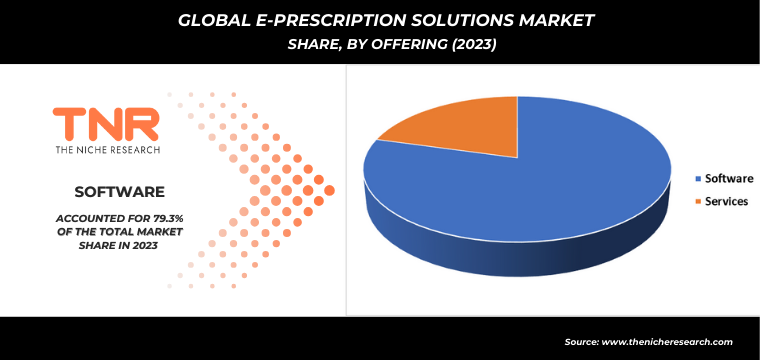
In 2023, on-premises segment solidified its position as the second-largest deployment model category within the global e-prescription solutions market. This model remains popular due to its control and security advantages, allowing healthcare organizations to manage and store data within their own infrastructure. On-premises solutions offer customized features tailored to specific organizational needs and comply with stringent regulatory requirements. Despite the growing trend towards cloud-based models, the on-premises deployment provides a reliable option for institutions prioritizing data sovereignty and integration with existing legacy systems, thereby maintaining its significant market share.
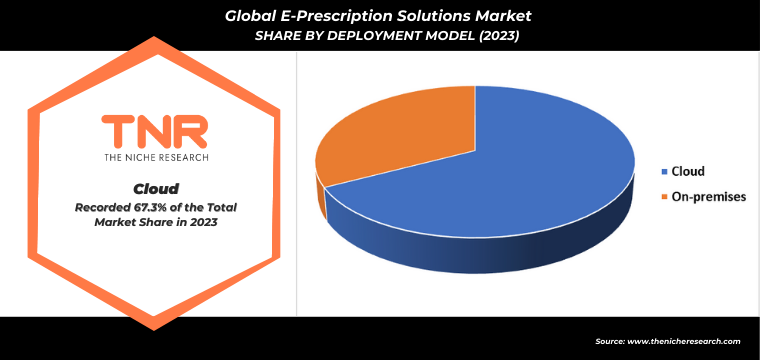
Web based segment, categorized by delivery mode, has exerted significant dominance over the global e-prescription solutions market. This dominance stems from the segment’s ability to offer flexible, scalable, and cost-effective solutions accessible via the internet. Web-based e-prescription systems enable healthcare providers to access real-time patient data and manage prescriptions from any location with an internet connection, facilitating improved coordination and efficiency. Additionally, these systems often feature automatic updates and integration with other digital health tools, reducing maintenance costs and enhancing functionality. The convenience of remote access, coupled with the ease of integration and lower upfront costs compared to on-premises solutions, has made web-based deployment the preferred choice for many healthcare organizations, further cementing its leading position in the market.
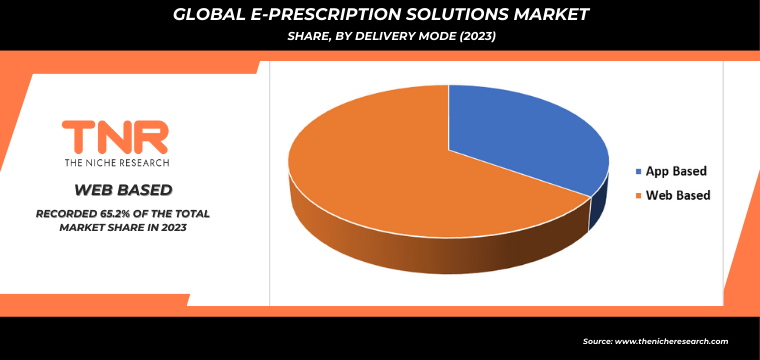
By end user, pharmacies segment is anticipated to grow fastest over the forecast timeline in global e-prescription solutions market. This growth is driven by the increasing adoption of digital solutions for streamlining prescription processing, reducing errors, and enhancing patient service. Pharmacies are leveraging e-prescription systems to efficiently manage and process a high volume of prescriptions, integrate with insurance and billing systems, and access real-time medication histories. The shift towards electronic methods improves operational efficiency and accuracy, making it an attractive option for pharmacies looking to modernize their operations and meet rising patient expectations.
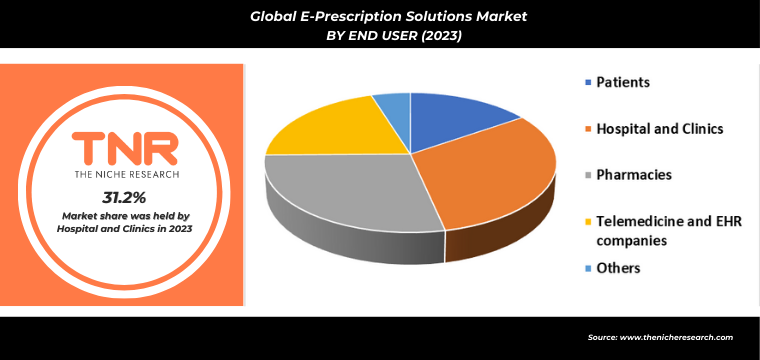
In 2023, North America solidified its dominance in the global e-prescription solutions market, contributing a revenue share of 33.6%. This dominance is attributed to several factors, including advanced healthcare infrastructure, high adoption rates of digital health technologies, and supportive government initiatives aimed at enhancing healthcare efficiency and reducing errors. The region’s strong emphasis on regulatory compliance and data security further drives the adoption of e-prescription solutions. The presence of leading technology providers and a robust healthcare system that supports the integration of electronic health records (EHR) contribute to North America’s leading position. This trend underscores North America’s role as a key player in shaping the future of e-prescription technology.
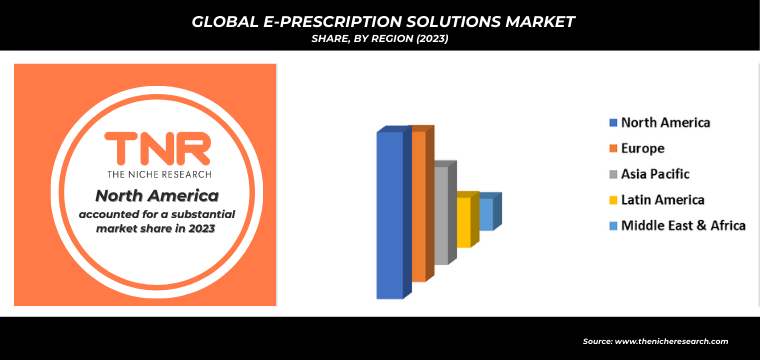
Competitive Landscape
Some of the players operating in the e-prescription solutions market are
- Allscripts Healthcare, LLC
- Athenahealth
- Cerner Corporation (Oracle)
- Change Healthcare
- DrFirst
- Epic Systems Corporation
- McKesson Corporation
- Networking Technology, Inc. (RXNT)
- NXGN Management, LLC
- Practice Fusion, Inc.
- Surescripts
- Other Industry Participants
Global E-Prescription Solutions Market Scope
| Report Specifications | Details |
| Market Revenue in 2023 | US$ 3.7 Bn |
| Market Size Forecast by 2034 | US$ 37.2 Bn |
| Growth Rate (CAGR) | 23.4% |
| Historic Data | 2016 – 2022 |
| Base Year for Estimation | 2023 |
| Forecast Period | 2024 – 2034 |
| Report Inclusions | Market Size & Estimates, Market Dynamics, Competitive Scenario, Trends, Growth Factors, Market Determinants, Key Investment Segmentation, Product/Service/Solutions Benchmarking |
| Segments Covered | By Offering, By Deployment Model, By Delivery Mode, By End User, By Region |
| Regions Covered | North America, Europe, Asia Pacific, Middle East & Africa, Latin America |
| Countries Covered | U.S., Canada, Mexico, Rest of North America, France, The UK, Spain, Germany, Italy, Nordic Countries (Denmark, Finland, Iceland, Sweden, Norway), Benelux Union (Belgium, The Netherlands, Luxembourg), Rest of Europe, China, Japan, India, New Zealand, Australia, South Korea, Southeast Asia (Indonesia, Thailand, Malaysia, Singapore, Rest of Southeast Asia), Rest of Asia Pacific, Saudi Arabia, UAE, Egypt, Kuwait, South Africa, Rest of Middle East & Africa, Brazil, Argentina, Rest of Latin America |
| Key Players | Allscripts Healthcare, LLC, Athenahealth, Cerner Corporation (Oracle), Change Healthcare, DrFirst, Epic Systems Corporation, McKesson Corporation, Networking Technology, Inc. (RXNT), NXGN Management, LLC, Practice Fusion, Inc., Surescripts |
| Customization Scope | Customization allows for the inclusion/modification of content pertaining to geographical regions, countries, and specific market segments. |
| Pricing & Procurement Options | Explore purchase options tailored to your specific research requirements |
| Contact Details | Consult With Our Expert
Japan (Toll-Free): +81 663-386-8111 South Korea (Toll-Free): +82-808- 703-126 Saudi Arabia (Toll-Free): +966 800-850-1643 United Kingdom: +44 753-710-5080 United States: +1 302-232-5106 E-mail: askanexpert@thenicheresearch.com
|
Global E-Prescription Solutions Market
By Offering
- Software
- Integrated Solutions
- Standalone Solutions
- Services
By Deployment Model
- Cloud
- On-premises
By Delivery Mode
- App Based
- Web Based
By End User
- Patients
- Hospital and Clinics
- Pharmacies
- Telemedicine and EHR companies
- Others
By Region
- North America (U.S., Canada, Mexico, Rest of North America)
- Europe (France, The UK, Spain, Germany, Italy, Nordic Countries (Denmark, Finland, Iceland, Sweden, Norway), Benelux Union (Belgium, The Netherlands, Luxembourg), Rest of Europe)
- Asia Pacific (China, Japan, India, New Zealand, Australia, South Korea, Southeast Asia (Indonesia, Thailand, Malaysia, Singapore, Rest of Southeast Asia), Rest of Asia Pacific)
- Middle East & Africa (Saudi Arabia, UAE, Egypt, Kuwait, South Africa, Rest of Middle East & Africa)
- Latin America (Brazil, Argentina, Rest of Latin America)
Report Layout:
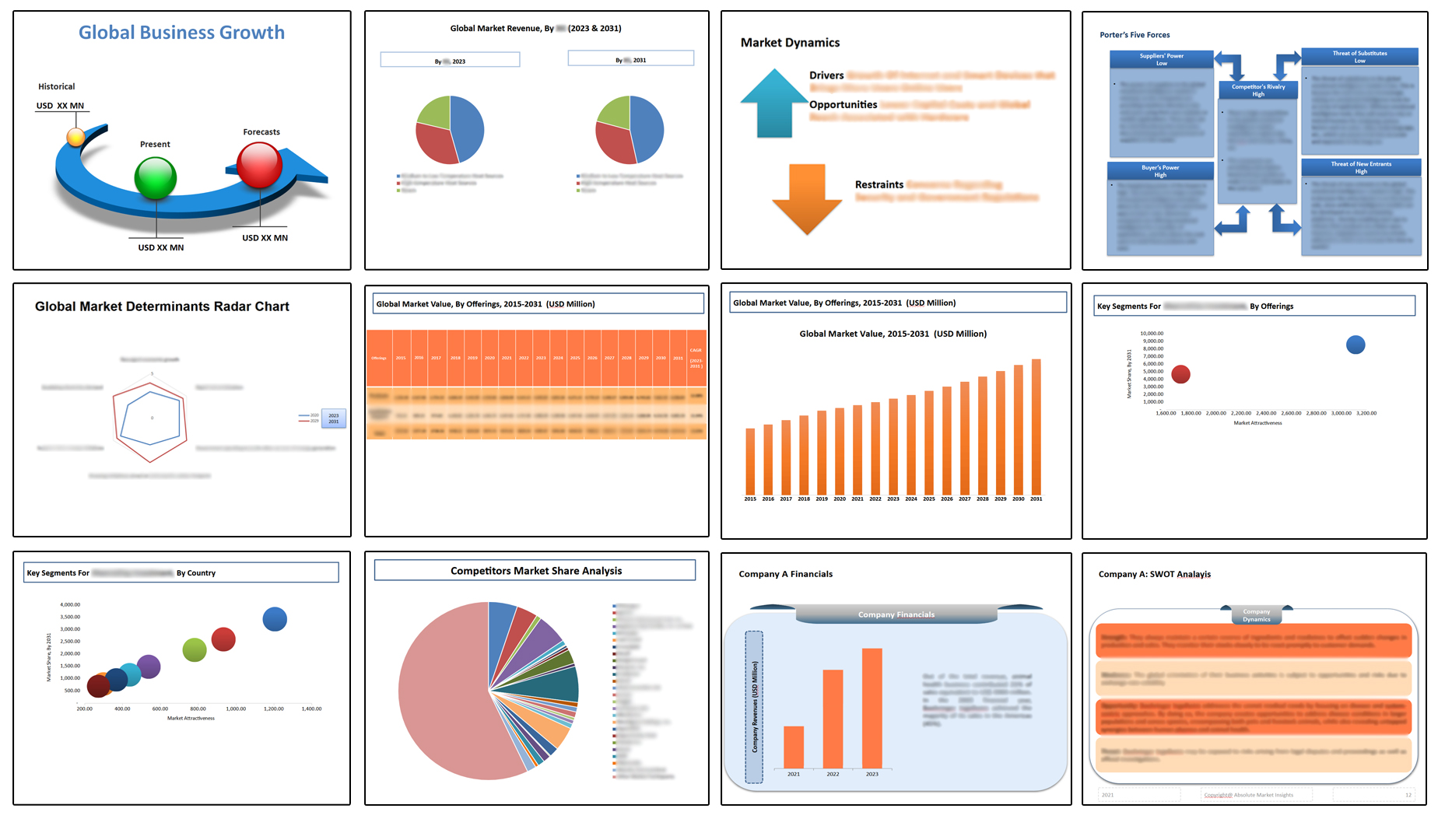
Table of Contents
Note: This ToC is tentative and can be changed according to the research study conducted during the course of report completion.
**Exclusive for Multi-User and Enterprise User.
Global E-Prescription Solutions Market
By Offering
- Software
- Integrated Solutions
- Standalone Solutions
- Services
By Deployment Model
- Cloud
- On-premises
By Delivery Mode
- App Based
- Web Based
By End User
- Patients
- Hospital and Clinics
- Pharmacies
- Telemedicine and EHR companies
- Others
By Region
- North America (U.S., Canada, Mexico, Rest of North America)
- Europe (France, The UK, Spain, Germany, Italy, Nordic Countries (Denmark, Finland, Iceland, Sweden, Norway), Benelux Union (Belgium, The Netherlands, Luxembourg), Rest of Europe)
- Asia Pacific (China, Japan, India, New Zealand, Australia, South Korea, Southeast Asia (Indonesia, Thailand, Malaysia, Singapore, Rest of Southeast Asia), Rest of Asia Pacific)
- Middle East & Africa (Saudi Arabia, UAE, Egypt, Kuwait, South Africa, Rest of Middle East & Africa)
- Latin America (Brazil, Argentina, Rest of Latin America)
The Niche Research approach encompasses both primary and secondary research methods to provide comprehensive insights. While primary research is the cornerstone of our studies, we also incorporate secondary research sources such as company annual reports, premium industry databases, press releases, industry journals, and white papers.
Within our primary research, we actively engage with various industry stakeholders, conducting paid interviews and surveys. Our meticulous analysis extends to every market participant in major countries, allowing us to thoroughly examine their portfolios, calculate market shares, and segment revenues.
Our data collection primarily focuses on individual countries within our research scope, enabling us to estimate regional market sizes. Typically, we employ a bottom-up approach, meticulously tracking trends in different countries. We analyze growth drivers, constraints, technological innovations, and opportunities for each country, ultimately arriving at regional figures.Our process begins by examining the growth prospects of each country. Building upon these insights, we project growth and trends for the entire region. Finally, we utilize our proprietary model to refine estimations and forecasts.
Our data validation standards are integral to ensuring the reliability and accuracy of our research findings. Here’s a breakdown of our data validation processes and the stakeholders we engage with during our primary research:
- Supply Side Analysis: We initiate a supply side analysis by directly contacting market participants, through telephonic interviews and questionnaires containing both open-ended and close-ended questions. We gather information on their portfolios, segment revenues, developments, and growth strategies.
- Demand Side Analysis: To gain insights into adoption trends and consumer preferences, we reach out to target customers and users (non-vendors). This information forms a vital part of the qualitative analysis section of our reports, covering market dynamics, adoption trends, consumer behavior, spending patterns, and other related aspects.
- Consultant Insights: We tap into the expertise of our partner consultants from around the world to obtain their unique viewpoints and perspectives. Their insights contribute to a well-rounded understanding of the markets under investigation.
- In-House Validation: To ensure data accuracy and reliability, we conduct cross-validation of data points and information through our in-house team of consultants and utilize advanced data modeling tools for thorough verification.
The forecasts we provide are based on a comprehensive assessment of various factors, including:
- Market Trends and Past Performance (Last Five Years): We accurately analyze market trends and performance data from preceding five years to identify historical patterns and understand the market’s evolution.
- Historical Performance and Growth of Market Participants: We assess the historical performance and growth trajectories of key market participants. This analysis provides insights into the competitive landscape and individual company strategies.
- Market Determinants Impact Analysis (Next Eight Years): We conduct a rigorous analysis of the factors that are projected to influence the market over the next eight years. This includes assessing both internal and external determinants that can shape market dynamics.
- Drivers and Challenges for the Forecast Period:Identify the factors expected to drive market growth during the forecast period, as well as the challenges that the industry may face. This analysis aids in deriving an accurate growth rate projection.
- New Acquisitions, Collaborations, or Partnerships: We keep a close watch on any new acquisitions, collaborations, or partnerships within the industry. These developments can have a significant impact on market dynamics and competitiveness.
- Macro and Micro Factors Analysis:A thorough examination of both macro-level factors (e.g., economic trends, regulatory changes) and micro-level factors (e.g., technological advancements, consumer preferences) that may influence the market during the forecast period.
- End-User Sentiment Analysis: To understand the market from the end-user perspective, we conduct sentiment analysis. This involves assessing the sentiment, preferences, and feedback of the end-users, which can provide valuable insights into market trends.
- Perspective of Primary Participants: Insights gathered directly from primary research participants play a crucial role in shaping our forecasts. Their perspectives and experiences provide valuable qualitative data.
- Year-on-Year Growth Trend: We utilize a year-on-year growth trend based on historical market growth and expected future trends. This helps in formulating our growth projections, aligning them with the market’s historical performance.
Research process adopted by TNR involves multiple stages, including data collection, validation, quality checks, and presentation. It’s crucial that the data and information we provide add value to your existing market understanding and expertise. We have also established partnerships with business consulting, research, and survey organizations across regions and globally to collaborate on regional analysis and data validation, ensuring the highest level of accuracy and reliability in our reports.









